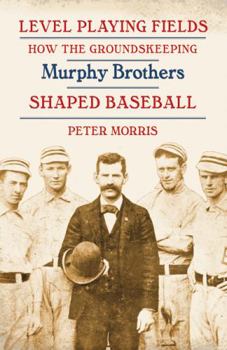Level Playing Fields: How the Groundskeeping Murphy Brothers Shaped Baseball
Select Format
Select Condition 
Book Overview
Most baseball fans want to hear about stellar players and spectacular plays, statistics and storied franchises. Level Playing Fields sheds light on a usually unnoticed facet of the game, introducing fans and historians alike to the real fundamentals of baseball: dirt and grass. In this lively history, Peter Morris demonstrates that many of the game's rules and customs actually arose as concessions to the daunting practical difficulties of creating a baseball diamond. Recovering a nearly lost and decidedly quirky chapter of baseball history, Level Playing Fields tells the engaging story of Tom and Jack Murphy, brothers who made up baseball's first great family of groundskeepers and who played a pivotal role in shaping America's national pastime. Irish immigrants who tirelessly crafted home-field advantages for some of baseball's earliest dynasties, the brothers Murphy were instrumental in developing pitching mounds, permanent spring training sites, and new irrigation techniques, and their careers were touched by such major innovations as tarpaulins and fireproof concrete-and-steel stadiums. Level Playing Fields is a real-life saga involving craftsmanship, resourcefulness, intrigue, and bitter rivalries (including attempted murder ) between such legendary figures as John McGraw, Connie Mack, Honus Wagner, and Ty Cobb. The Murphys' story recreates a forgotten way of life and gives us a sense of why an entire generation of American men found so much meaning in the game of baseball.
Format:Paperback
Language:English
ISBN:0803246307
ISBN13:9780803246300
Release Date:January 2013
Publisher:University of Nebraska Press
Length:194 Pages
Weight:0.65 lbs.
Dimensions:0.6" x 5.5" x 8.4"
Customer Reviews
1 rating
A Unique Subject is Covered Very Well
Published by Thriftbooks.com User , 18 years ago
A number of years ago I remember reading the following lines: Sometimes a team to triumph mounts When a baseball takes a lucky bounce. Before you credit fortunes wiles Ponder first the groundcrews' smiles. To be sure this is certainly a different type of baseball book. I remember reading Fred Lieb's account of the Baltimore Orioles of the 1890's of John McGraw, Willie Keeler, Hughey Jennings, and other colorful characters that made up this team, and now author Peter Morris has expanded on this team by including their legendary groundskeeper Tom Murphy. It was Tom who slanted the baselines to make sure that bunts remained in fair territory, and who sprinkled soap chips around the pitcher's mound so enemy hurlers wouldn't be able to properly grip a baseball. What eventually became of Tom we don't know, but he did take a baseball bat to Connie Mack's brother Dennis's head. He skipped bail and the following summmer Connie recognized him on a street in St. Louis. Murphy was arrested, tried and convicted of assault and spent nearly three years in prison. Brother John Murphy spent a number of years as groundskeeper at the Polo Grounds, the storied home of the New York Giants. John was hired by Giants' owner John T. Brush who was familiar with Murphy from their days together in Indianapolis. The early steel and concrete ballparks often had their own personality and quirks as the park had to be built in the shape of land that was available for sale. Hence, the bathtub shape of the Polo Grounds, also known as the Horseshoe on the Harlem. The book also includes the New York Highlanders' efforts to gain a foothold in New York at the turn of the 20th century. Dynamite had to be used to remove rock on the upper west side of Manhattan where the New York Presbyterian Medical Center now stands. I found this to be an interesting book on a unique subject. I learned some things I wasn't aware of, and the pictures are also interesting including one of John T. Brush which I had never seen before.






